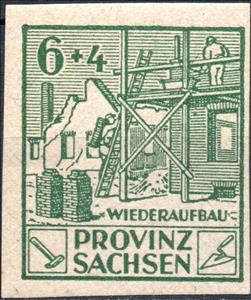Stamp: Wiederaufbau (Germany, Soviet Occupation of Saxony 1946)
Wiederaufbau (Germany, Soviet Occupation of Saxony 1946)
21 February (Germany, Soviet Occupation of Saxony ) within release Saxony : Reconstruction goes into circulation Stamp Wiederaufbau face value 6+4 German reichspfennig
| Stamp Wiederaufbau in catalogues | |
|---|---|
| Michel: | Mi: DD 87BIII |
Stamp is vertical format.
Plate Flaw: Colour spot left of right window (Field 4, 9, 54, 59)Stamp Wiederaufbau it reflects the thematic directions:
Architecture (Latin architectura, from the Greek ἀρχιτέκτων arkhitekton "architect", from ἀρχι- "chief" and τέκτων "builder") is both the process and the product of planning, designing, and constructing buildings and other physical structures. Architectural works, in the material form of buildings, are often perceived as cultural symbols and as works of art. Historical civilizations are often identified with their surviving architectural achievements.
Construction is a general term meaning the art and science of forming objects, systems, or organizations. It comes from the Latin word constructio (from com- "together" and struere "to pile up") and Old French construction. To 'construct' is a verb: the act of building, and the noun is construction: how something is built or the nature of its structure.
A building or edifice is a structure with a roof and walls standing more or less permanently in one place, such as a house or factory. Buildings come in a variety of sizes, shapes and functions, and have been adapted throughout history for a wide number of factors, from building materials available, to weather conditions, to land prices, ground conditions, specific uses and aesthetic reasons. Buildings serve several needs of society – primarily as shelter from weather, security, living space, privacy, to store belongings, and to comfortably live and work. A building as a shelter represents a physical division of the human habitat (a place of comfort and safety) and the outside (a place that at times may be harsh and harmful).



